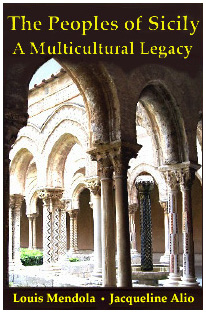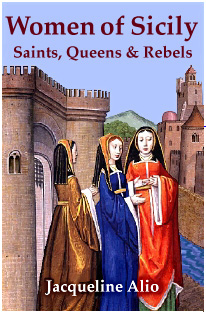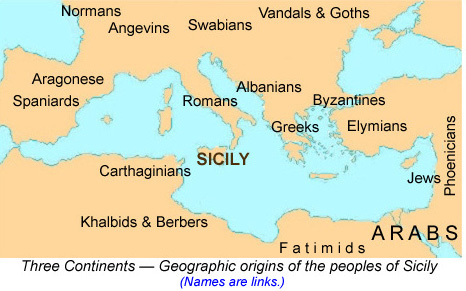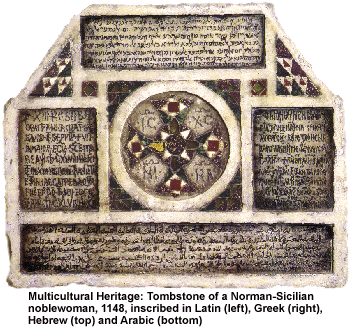...Best of Sicily presents... Best of Sicily Magazine. ... Dedicated to Sicilian art, culture, history, people, places and all things Sicilian. |
by Luigi Mendola | |||
Magazine Index Best of Sicily Arts & Culture Fashion Food & Wine History & Society About Us Travel Faqs Contact Map of Sicily
|
Enlightenment has never been a particularly rapid process, but it has been interesting to witness an increasing recognition of the concept of cultural diversity over the last few decades. The idea itself is nothing new. It was known in medieval Sicily. Some of us believe it actually began here, pushed along by distinguished rulers like Roger II and his grandson Frederick II, two of the most enlightened monarchs of the Middle Ages. Medieval Byzantine and Arab society were highly advanced for their time, certainly compared to the societies of north-western and central Europe during the same period, and it is clear that in Sicily much Norman and Swabian-German wisdom was a reaction to the seeds planted in Sicily by those two great civilizations. Nothing in Normandy or the Angevin-French or German realms was like the culture and wealth of Sicily by the early decades of the eleventh century. Because the editors of this site receive hundreds of emails each day
(in addition to the spam), we can't respond to more than a tiny fraction
of them. Here are examples of a particular kind of comment we get at least
a few times each month:
• "Sicilians are African/European/Greek/Arab/Italian!" Plato and Abdullah al Idrisi, not to mention Roger and Frederick, would beg to differ with such remarks. These comments make it clear that certain critics have ignored the ancient and medieval history of Sicily and the Mediterranean - and a number of pages on this website and many others. Condescension aside, let's clarify a few points for the benefit of all our readers - be they Multiculturalist, Eurocentrist, Afrocentrist, Italianist, Racialist or other-ist. Sicily's Proto-Sicanian culture is one of the world's most ancient; Sicilians built Europe's oldest surviving temples (on Malta) circa 4,000 BC (BCE) and may even have invented the wheel. Humans were born in Africa, but in terms of our earliest cultural history - be it cave drawings, free-standing structures or the earliest writing - the Maltese temples, which predate the pyramids in Egypt and Stonehenge in England but not the older temples in Turkey, are as good a milestone as any. Even to the Phoenicians, Greeks and Romans, terms like Europe or Africa or Asia were little more indicative of global geography than such words as Iberia, Germania, Numidia or Gaul. In terms of rights and citizenship, the Romans themselves made little distinction among the various tribal and "ethnic" groups that inhabited their vast Empire covering parts of what are now considered all three continents; during Rome's thousand-year dominance there were senators and governors and emperors from all three regions. Naturally, they acknowledged the cultural and linguistic differences between Germans, Gauls, Greeks, Egyptians, Hebrews and Persians but for centuries Roman rule, however harsh it was, found its basis in the simple idea that the Mediterranean was the centre of the Roman world. The Romans, like the Phoenicians and Greeks before them, gave little thought to the concept of "intercontinental" travel from Asia Minor to northern Africa to southern Europe as representing a great cultural or "racial" achievement; that Mediterranean waters touched all three regions was a simple fact of life, politics, trade and culture. With the use of terms such as "Pacific Rim" to describe cultures or economies by the bodies of water they border rather than by their continental land masses, the term "Mediterranean" has again become popular in recent decades. Considering that the ancient and early-medieval (pre AD 1000) peoples of southern Europe, Asia Minor and northern Africa were genetically close, and also culturally similar in many respects, we prefer to define them as Mediterranean rather than European, Asian or African - partly because broad geographical definitions (based on continents) had little political meaning until "new" places (like America) were "discovered" at the end of the Middle Ages. The "European" Romans scarcely knew of the existence of the Lapps of northern Scandinavia, a unique ethnic group. Though the Egyptians had contact with Ethiopia, the "African" Carthaginians and Saracens had little, if any, knowledge of the peoples of what is now Zambia. Via the Persians, the Phoenicians traded with India and even Mongolia (and may have circumnavigated Africa), but they probably knew nothing of Japanese civilization. Despite political differences, the Romans had more in common with the Carthaginians than with most northern European groups, while the Carthaginians had more in common with the Persians than with most sub-Saharan peoples. This "cultural" perspective of Mediterranean ethnography is far from perfect, but it compares favourably to the blind geographic point of view espoused by those who would have us believe otherwise. Then there's the very relevant question of genetic haplogroups, of which Sicily has a great number, reflecting the island being home to many peoples over time. In view of their common roots, the ancient Sicilians were overwhelmingly similar to the Byzantine greeks, and to the Saracens who conquered the Byzantines, yet the Normans and Germans were not so different as to be considered "aliens." Was Sicily geographically part of Africa when it was ruled by Carthaginians or Saracens, only to be "reintegrated" into Europe when it was ruled by Romans and Normans? That's a good question, but one that was rarely posed before our modern era. At no time in history did any conquering people completely expel the people who inhabited Sicily before them. There was assimilation (culturally) and then amalgamation (genetically). These facts are easily proven through the contemporary written (historical) record and (more recently) through genetic studies of the population. By 1300 the Muslim-Arab and Greek-Orthodox populations had assimilated with the "Latin" culture embodied in the Roman Catholic Church, and in 1493 the Jews who did not leave Sicily converted to Catholicism. Most Sicilians are most likely descended from all of these peoples.
There are numerous examples to support historical fact. The existence of the New Testament books of the Bible written in Sicily in Arabic during the twelfth century are a reliable indication of Muslim conversions to Christianity. Census, baptismal and notary records referring explicitly to converted Jews (or anusim) after 1493 are equally reliable, not to mention numerous decrees, feudal records and chronicles relative to these peoples. And of course such things as the tombstone shown here. Byzantium (Constantinople, now Istanbul) straddled Europe and Asia Minor, while Phoenicia was in the westernmost part of Asia. Most geographers identify the Arabian Peninsula as Asian. Any expansion westward across the Mediterranean from these regions necessarily included Sicily in the middle of this Sea. As the Greeks, Romans and Carthaginians (and later the Byzantines and Arabs) knew, it was impossible to control the entire Mediterranean without controlling Sicily; coming from the West, it occurred to the Normans, Swabians and Aragonese to use Sicily as an anchor in a conquest of the East, though their campaigns in this regard met with only limited success. It's a telling fact that the most immediate effects of the Great Schism dividing Christianity into East (Roman) and West (Byzantine) were felt here in Sicily. A case could even be made for Trapani being in the western Mediterranean, Syracuse in the eastern part and Agrigento in the south - an island divided into three parts. Cruise lines usually include Messina or Catania in their eastern Mediterranean itineraries, but Palermo and Trapani in the western ones. Ethnic, racial and even geographic identity are too complex to be addressed fully here, or in any single book. In our world we see national boundaries and identities challenged daily. "Italy" has existed as a nation state only since 1861 and in many ways remains a country greatly divided. Sicily, on the other hand, was historically - if all too briefly - a place where continents and cultures came together. The Sicilians are altogether far more complex. About the Author: Historian Luigi Mendola has written for various publications, including this one. | ||
Top of Page |


 Most people visit Sicily for at least one of three very good reasons: the
Most people visit Sicily for at least one of three very good reasons: the 
 Genetics aside, how do we know this?
Genetics aside, how do we know this?